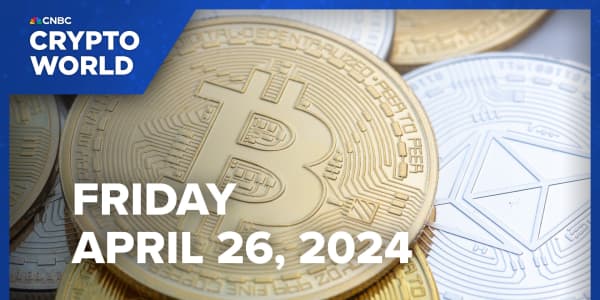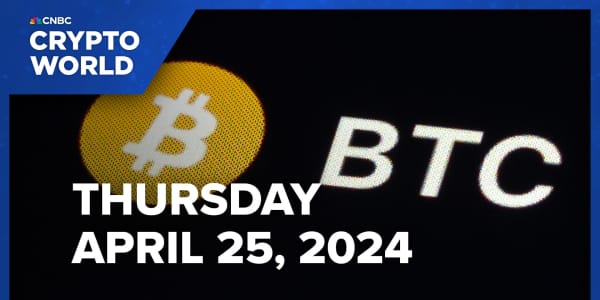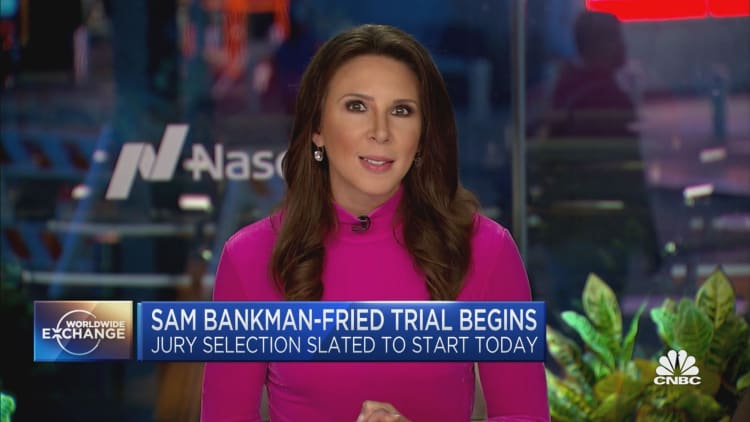
A year ago, Sam Bankman-Fried was revered as a titan of the industry and living large at a $40 million penthouse in the Bahamas, while he ran a crypto empire valued at $32 billion. On Tuesday morning in a Manhattan federal court in New York, the now disgraced founder and ex-CEO of the bankrupt crypto exchange FTX will stand trial for allegedly masterminding one of the biggest financial frauds in U.S. history.
Here is what you need to know about the multi-week trial that starts today, the government's case against 31-year-old Bankman-Fried, and how we got here.
The trial(s) against Sam Bankman-Fried
Tuesday marks the start of the first of two separate criminal trials against the man once celebrated as a titan of the industry.
In the first trial, Bankman-Fried faces seven criminal counts related to the collapse of the crypto empire he built, including wire fraud, securities fraud and money laundering.
A superseding indictment alleges that Bankman-Fried misused billions of dollars worth of customer money for personal purchases, including buying more than $200 million of upscale real estate properties in the Bahamas, as well as to cover bad bets made at his crypto hedge fund, Alameda Research. The government says customer cash was shuttled to Alameda via two channels: Users depositing cash directly into accounts held by Alameda and through a secret backdoor that was baked into FTX's code.
Prosecutors from the Southern District of New York, who contend that more than $8 billion of customers' money has gone missing, also allege that Bankman-Fried defrauded FTX investors by covering up the scheme.
The government has separately accused SBF of using customer funds to make more than $100 million in campaign contributions for the 2022 midterm elections.
The full list of charges are:
- Conspiracy to commit wire fraud on customers of FTX.
- Wire fraud on customers of FTX.
- Conspiracy to commit wire fraud on lenders to Alameda Research.
- Wire fraud on lenders to Alameda Research.
- Conspiracy to commit fraud on customers of FTX in connection with purchase and sale of derivatives.
- Conspiracy to commit securities fraud on investors in FTX.
- Conspiracy to commit money laundering.
A conviction on all counts could land him more than 100 years in prison. Bankman-Fried, who is the son of two Stanford legal scholars, has pleaded not guilty to all charges.
Bankman-Fried's criminal trial is expected to last up to six weeks, and it kicks off at 9:30 a.m. ET on Tuesday with jury selection. From there, the prosecution will take roughly four weeks to lay out its case, and the defense will take another one to two weeks to present its side.
It's not yet known whether Bankman-Fried will testify, but the witness roster is expected to include his top deputies at FTX and Alameda, who also happened to comprise his innermost social circle before his crypto empire imploded.
The list of cooperating witnesses anticipated to take the stand include Bankman-Fried's ex-girlfriend, Caroline Ellison, and his ex-best friend from high school math camp and former MIT roommate, Gary Wang.
Ellison, who is the former chief executive of Alameda Research, and FTX co-founder Wang, both pleaded guilty in December to multiple charges and have been cooperating with the U.S. attorney's office in Manhattan for months.
Since August, Bankman-Fried has been held in a jail in Brooklyn, New York, after having his multimillion-dollar bail revoked for witness tampering, after allegedly leaking to The New York Times the private diary entries of Ellison, who is expected to be a star witness for the prosecution.
Court documents filed so far indicate that lawyers for Bankman-Fried could present an "advice of counsel" defense. That's where they would say that he was following the guidance of FTX lawyers and didn't realize that what he was doing was illegal. Judge Lewis Kaplan has already ruled, however, that this defense strategy cannot be included in their opening remarks since it might risk prejudicing the jury from the start.
A second criminal trial is slated for March 2024 that will deal with additional charges brought after Bankman-Fried's extradition to the U.S. from FTX's headquarters in the Bahamas.
How we got here
The Kimchi Swap put Sam Bankman-Fried on the map.
The year was 2017, and the ex-Jane Street Capital quant trader noticed something funny when he looked at the page on CoinMarketCap.com listing the price of bitcoin on exchanges around the world. Today, that price is pretty much uniform across the exchanges, but back then, Bankman-Fried previously told CNBC, he would sometimes see a 60% difference in the value of the coin. His immediate instinct, he said, was to get in on the arbitrage trade — buying bitcoin on one exchange, selling it back on another exchange, and then earning a profit equivalent to the price spread.
"That's the lowest hanging fruit," Bankman-Fried said in September.
The arbitrage opportunity was especially compelling in South Korea, where the exchange-listed price of bitcoin was significantly more than in other countries. It was dubbed the Kimchi Premium — a reference to the traditional Korean side dish of salted and fermented cabbage.
After a month of personally dabbling in the market, Bankman-Fried launched his own trading house, Alameda Research — named after his hometown of Alameda, California, near San Francisco — to scale the opportunity and work on it full time. Bankman-Fried said in an interview with CNBC that the firm sometimes made as much as a million dollars a day.
Part of why SBF earned street cred for carrying out a relatively straightforward trading strategy was because it wasn't the easiest thing to execute on crypto rails five years ago. Bitcoin arbitrage involved setting up connections to each one of the trading platforms, as well as building out other complicated infrastructure to abstract away a lot of the operational aspects of making the trade. Bankman-Fried's Alameda became very good at that, and the money rolled in.
From there, the SBF empire ballooned.
Alameda's success spurred the launch of crypto exchange FTX. In April 2019, Bankman-Fried and Wang — along with University of California, Berkeley, graduate Nishad Singh — founded FTX.com, an international cryptocurrency exchange that offered customers innovative trading features, a responsive platform and a reliable experience. FTX's success begat a $2 billion venture fund that seeded other crypto firms. Bankman-Fried's personal wealth grew to around $26 billion at its peak.
Bankman-Fried was suddenly the poster boy for crypto everywhere, and the FTX logo adorned everything from Formula One race cars to a Miami basketball arena. He went on an endless press tour, bragged about having a balance sheet that could one day buy Goldman Sachs, and became a fixture in Washington, where he was one of the Democratic Party's top donors, promising to sink $1 billion into U.S. political races before later backtracking.
It was all a mirage.
As crypto prices tanked in 2022, Bankman-Fried boasted that he and his enterprise were immune. But in fact, the sectorwide wipeout hit his operation quite hard. Alameda borrowed money to invest in failing digital asset firms in the spring and summer of 2022 to keep the industry afloat, then reportedly siphoned off FTX customers' deposits to stave off margin calls and meet immediate debt obligations. A fight on Twitter, now known as X, with the CEO of rival exchange Binance pulled the mask off the scheme.
Alameda, FTX and a host of subsidiaries Bankman-Fried founded filed for bankruptcy protection in Delaware. Bankman-Fried lost 94% of his personal wealth in a single day; was arrested in the Bahamas; was subsequently extradited to the U.S. and taken into custody; was released on a $250 million bail to his parents' California home; and then later remanded back into custody for alleged witness tampering.
Meanwhile, federal prosecutors and regulators have accused Bankman-Fried of not just having perpetrated a fraud, but having done so "from the start," according to a filing from the Securities Exchange Commission.
SEC and Commodity Futures Trading Commission regulators, alongside federal prosecutors from the United States Attorney's Office for the Southern District of New York, say that Bankman-Fried was at the heart — indeed, the driver — of "one of the biggest financial frauds in American history," in the words of U.S. Attorney Damian Williams.
Federal regulators at the CFTC say that just a month after founding FTX.com, Bankman-Fried, "unbeknownst to all but a small circle of insiders," was leveraging customer assets — specifically, customers' personal cryptocurrency deposits — for Alameda's own bets.
Rehypothecation is the term for when businesses legally use customer assets to speculate and invest. But Bankman-Fried didn't have permission from customers to gamble with their funds. FTX's own terms of use specifically forbade him, or Alameda, from using customer money for anything — unless the customer allowed it.
And from FTX's inception, there was a lot of customer money. The CFTC cited 2019 reports from FTX which pegged the futures volume alone as often exceeding $100 million every day.
Using customer money for Alameda's bets constituted fraud, the CFTC alleges. From the very genesis of FTX, regulators allege, Bankman-Fried was using customer funds to bankroll his speculative investments.
It was a steep fall from hero to villain. But there were a lot of signs.
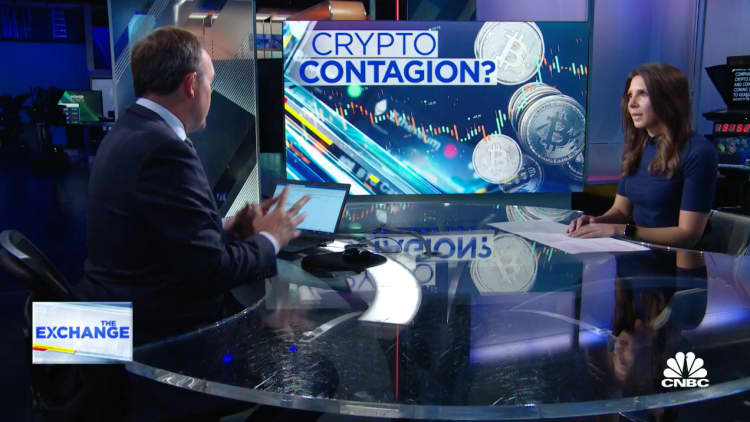
A lousy crypto hedge fund
Despite the deck being stacked in Alameda's favor, the hedge fund offered terrible returns. A court filing indicated that Alameda lost more than $3.7 billion over its lifetime, despite public statements by FTX leaders touting how profitable the trading arm was.
Alameda's losses and lending structure were a critical component of FTX's eventual collapse.
Alameda didn't just allegedly play fast and loose with customer money. The hedge fund borrowed aggressively from multiple lenders, including Voyager Digital and BlockFi Lending. Both those companies entered Chapter 11 bankruptcy proceedings in 2022, and FTX targeted both for acquisition.
Alameda secured its loans from Voyager and BlockFi with FTT tokens, which FTX minted itself. Bankman-Fried's empire controlled the vast majority of the available currency, with only a small amount of FTT actually circulating at any time.
Alameda should have acknowledged the fact that its tokens couldn't be sold at the price that they claimed they were worth, the CFTC alleges in its complaint.
This was because any attempt by Alameda to sell off their FTT tokens would crater FTT's price, given how much of the available supply Alameda controlled.
Instead of correctly marking its tokens to market, though, Alameda marked their entire hoard of FTT at the prevailing market price.
Alameda used this methodology with other coins as well, including Solana and Serum (a token created and promoted by FTX and Alameda), using them to collateralize billions in loans to other crypto players. Industry insiders even had a nickname for those tokens — "Sam coins."
The tables began to turn in May 2022 after the collapse of Luna, a stablecoin whose implosion and subsequent crash devastated other lenders and crypto firms and sent crypto prices plunging. Major Alameda lenders, like Voyager, declared bankruptcy. Remaining lenders began to execute margin calls or liquidate open positions with customers, including Alameda.
The CFTC alleges that between May and June 2022, Alameda was subjected to "a large number of margin calls and loan recalls."
Unbeknownst to investors, lenders, or regulators, Alameda lacked enough liquid assets to service its loan obligations.
But while Alameda was illiquid, FTX's customers — who had been constantly reassured that the exchange, and Bankman-Fried, were determined to protect their interests — were not.
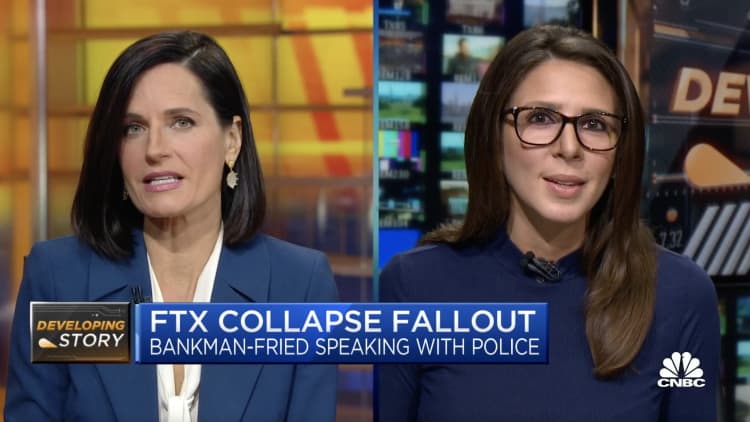
The fraud — exposed
Bankman-Fried stepped down from his leadership position at Alameda Research in Oct. 2021 in what CFTC regulators claim was a calculated bid to cultivate a false sense of separation between FTX and the hedge fund. But he continued to exercise control, regulators claim.
Bankman-Fried allegedly ordered Alameda to increase its use of customer assets, drawing down massively on its "unlimited" credit line at FTX.
"Alameda was able to rely on its undisclosed ordinary-course access to FTX credit and customer funds to facilitate these large withdrawals, which were several billion dollars in notional value," the CFTC filing reads.
By the middle of 2022, Alameda owed FTX's unwitting customers approximately $8 billion. Bankman-Fried had testified before the House that FTX boasted world-class risk management and compliance systems, but in reality, according to the firm's own bankruptcy filings, it possessed almost nothing in the way of record-keeping.
Then, on Nov. 2, the first domino fell. Crypto trade publication CoinDesk publicized details on Alameda's balance sheet which showed $14.6 billion in assets. Over $7 billion of those assets were either FTT tokens or Bankman-Fried-backed coins like Solana or Serum. Another $2 billion were locked away in equity investments.
For the first time ever, the secretive inner workings of Alameda Research were revealed to be a Potemkin village. Investors began to liquidate their FTT tokens and withdraw their holdings from FTX, a potentially calamitous situation for Bankman-Fried.
Alameda still had billions of collateralized loans outstanding — but if the value of their collateral, FTT, fell too far, their lenders would execute further margin calls, demanding full repayment of loans.
Allegedly, Alameda had already been unable to fulfill loan obligations over the summer without accessing customer funds. Now, with money flowing out of the exchange and FTT's price slipping, Alameda and FTX faced a liquidity crunch.
In a now-deleted tweet, Bankman-Fried continued to claim FTX was fully funded and that customer assets were safe. But on Nov. 6, 2022, four days after the CoinDesk article, the crack widened into a chasm, thanks to an old investor-turned-rival, Changpeng "CZ" Zhao.
Zhao founded Binance in 2017, and it was the first outside investor in FTX, funding a Series A round in 2019. FTX bought out Binance in 2021 with a combination of FTT and other coins, according to Zhao.
Zhao dropped the hammer with a tweet saying that because of "recent revelations that have came [sic] to light, we have decided to liquidate any remaining FTT on our books."
FTX executives scrambled to contain the damage, and Alameda traders managed to fend off outflows for two days, holding the price of FTT at around $22.
Publicly, Bankman-Fried continued to operate as if all was well. "FTX is fine. Assets are fine," he wrote in a tweet on Nov. 7 that has since been deleted.
But at the same time Bankman-Fried was tweeting reassurances, internally, executives were growing more and more alarmed at the increasing shortfall, according to prosecutors. Bankman-Fried and other executives admitted to each other that "FTX customer funds were irrevocably lost because Alameda had appropriated them."
It was an admission that flew in the face of everything Bankman-Fried would claim publicly up through the day of his arrest, a month later.
By Nov. 8, the shortfall had grown from $1 billion to $8 billion. Bankman-Fried had been courting outside investors for a rescue package, but everyone declined.
FTX issued a pause on all customer withdrawals that day. FTT's price plummeted by over 75%. Bankman-Fried was in the midst of a high-tech, decentralized run on the bank. Out of options, he turned to Zhao, who announced that he'd signed a "non-binding" letter of intent to acquire FTX.com.
But just a day later, on Nov. 9, Binance said it would not go through with the acquisition, citing reports of "mishandled customer funds" and federal investigations.
Two days later, Bankman-Fried resigned as CEO of FTX and associated entities. FTX's longtime attorneys at Sullivan & Cromwell approached John J. Ray, who oversaw Enron through its bankruptcy, to assume Bankman-Fried's former position.
FTX filed for bankruptcy that same day, on Nov. 11, 2022. A month later, Bankman-Fried was arrested by Bahamian authorities, pending extradition on charges of fraud, conspiracy, and money laundering.
Bankman-Fried, a devotee of a philosophy known as "effective altruism," was apparently driven by an obsessive need to quantify the impact he had on this world, measured in dollars and tokens. He drafted a spreadsheet which measured the influence that Alameda had on the planet (and determined it was nearly a net wash).
Billions of dollars of customer money were left floating in venture funds, political war chests and charitable coffers, although John Ray's team has clawed back more than $7 billion so far.
Almost a decade ago, Bankman-Fried posed a hypothetical question to his friends and family on his personal blog: Waxing poetic on effective altruism, he asked rhetorically, "Just how much impact can a dollar have?"
"Well, if you want a one-sentence answer, here it is: one two thousandth of a life," he said.
The CFTC alleges that over $8 billion of customer funds are missing. Some customers have doubtless lost their life savings, their kid's college funds, their future down payments. By Bankman-Fried's own math, his alleged misdeeds were worth four million lives.
— CNBC's Rohan Goswami contributed to this report.





